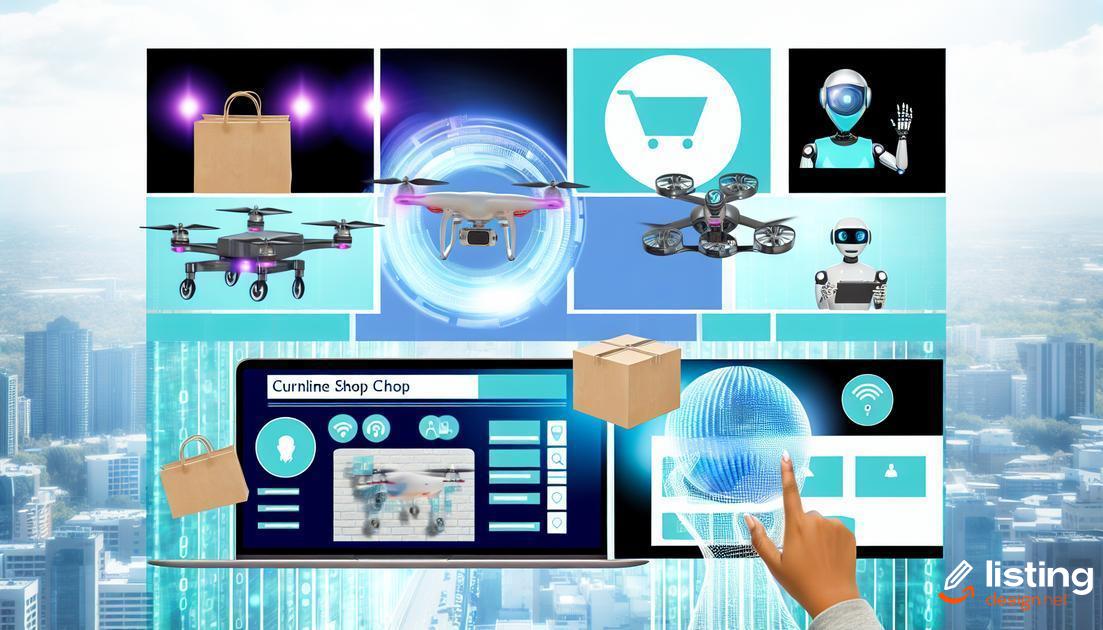The e-commerce landscape is evolving rapidly. Future trends in e-commerce indicate transformative changes in how consumers interact with online stores. As we look ahead, personalization and customer experience are top priorities, while mobile commerce continues to rise. Technologies like AI and machine learning are being integrated more frequently to offer better customer insights and personalized recommendations. Payment options are becoming more advanced, subscription models are growing in popularity, and social commerce is making a significant impact. Moreover, augmented reality is expanding, enhancing online shopping experiences, and there’s a rising emphasis on sustainable and ethical shopping practices. These trends will shape the e-commerce future, making online shopping more efficient and tailored to individual needs.
Table of Contents
1. Personalization and Customer Experience
Personalization is becoming a cornerstone of modern e-commerce. Online retailers are leveraging data to tailor shopping experiences to individual preferences. By analyzing browsing patterns, purchase histories, and even social media activity, businesses can offer customized product recommendations. This not only enhances customer satisfaction but also increases sales conversion rates.
Additionally, personalized marketing strategies such as targeted emails and personalized ads make customers feel valued. When shoppers receive recommendations that align with their interests, they are more likely to make repeat purchases.
Customer experience
goes hand-in-hand with personalization. A seamless, user-friendly interface is essential for retaining customers. Websites that are easy to navigate, load quickly, and provide clear product descriptions help to build trust and encourage purchases. Live chat support and efficient customer service also play crucial roles in enhancing the shopping experience.
In the future, we can expect even more advanced personalization techniques. Predictive analytics, for example, will become more accurate, helping businesses to anticipate customer needs before they arise.
2. Rise of Mobile Commerce

Accessibility and Convenience
The rise of mobile commerce, often referred to as m-commerce, is transforming how consumers shop online. With the increasing use of smartphones and tablets, people now have the ability to shop from anywhere at any time. This convenience is driving a significant shift from traditional e-commerce platforms to mobile-friendly interfaces.
Mobile Apps and Progressive Web Apps (PWAs)
Businesses are investing in mobile apps and Progressive Web Apps (PWAs) to enhance user experience. These mobile solutions offer faster loading times, offline capabilities, and push notifications, making it easier for customers to engage with brands on the go.
User Experience (UX)
A seamless user experience is crucial for mobile commerce success. This includes intuitive navigation, quick load times, and easy checkout processes. Companies are optimizing their websites for mobile devices by using responsive design techniques and simplifying their web layouts.
Mobile Payment Systems
Mobile payment systems like Apple Pay, Google Wallet, and various mobile banking apps are becoming more popular. These systems provide secure, fast, and convenient payment options, further encouraging consumers to complete their purchases via mobile devices.
Influence of Social Media
Social media platforms are integrating ‘buy now’ buttons and shopping features, allowing users to make purchases directly through the apps. Influencers and targeted ads also play a significant role in driving mobile commerce, as brands leverage social media to reach potential customers.
3. Integration of AI and Machine Learning
The integration of AI and Machine Learning has significantly reshaped the landscape of e-commerce. These technologies enhance customer interactions by providing personalized recommendations based on browsing and purchasing history. Machine learning algorithms analyze vast amounts of data to predict trends and consumer preferences, improving inventory management and reducing overstocking.
Moreover, AI-driven chatbots and virtual assistants offer real-time customer support, addressing queries and concerns efficiently. This leads to higher customer satisfaction and retention rates. Fraud detection is another critical area where AI proves beneficial. By identifying unusual patterns in transactions, it minimizes the risk of fraudulent activities, ensuring a safer shopping environment.
AI also plays a pivotal role in dynamic pricing strategies. By continuously monitoring competitor prices, supply, and demand, AI systems can adjust prices in real-time, maximizing profit margins while remaining competitive. Additionally, AI supports enhanced search functionality, enabling more accurate product searches and better user experiences.
In the warehouse and logistics domain, AI and robotics streamline operations, improving order fulfillment and reducing delivery times. Predictive maintenance powered by AI ensures that equipment downtime is minimized, maintaining smooth operations.
4. Advanced Payment Options

As e-commerce continues to evolve, advanced payment options are becoming increasingly important for providing a seamless customer experience. Consumers now seek convenience, security, and versatility in their payment methods.
Digital wallets, such as Apple Pay, Google Wallet, and Samsung Pay, are growing in popularity. These options offer a high level of security and can expedite the checkout process. Customers can complete their purchases with just a tap or a scan, reducing friction and enhancing overall user satisfaction.
Buy Now, Pay Later (BNPL) services are another trending payment solution. Companies like Klarna, Afterpay, and Affirm allow consumers to split their purchases into manageable installments, often without interest. This can drive higher conversion rates by making higher-priced items more accessible.
Cryptocurrency is also entering the mainstream as a viable payment option. More online retailers are starting to accept Bitcoin, Ethereum, and other digital currencies. This provides a layer of privacy and can attract tech-savvy customers.
Additionally, biometric authentication methods, such as fingerprint and facial recognition, are enhancing payment security. These technologies can significantly reduce fraud and protect sensitive customer information.
Another innovative option is the use of voice-activated payments. Smart assistants like Alexa and Google Assistant enable users to make purchases and transfer money using voice commands, adding a new level of convenience for shoppers.
Offering a variety of advanced payment options can differentiate an e-commerce business and cater to the diverse preferences of modern consumers. By staying ahead in payment technology, retailers can improve customer satisfaction, increase loyalty, and ultimately drive more sales.
5. Growth of Subscription Models
The growth of subscription models has reshaped the landscape of e-commerce. Customers are increasingly drawn to the convenience and cost-effectiveness of subscribing to products and services they use regularly. Subscription models provide a steady stream of revenue for businesses, helping predict sales more accurately and ensuring a consistent customer base.
Companies are innovating within this space by offering customizable subscription plans that cater to individual needs. For example, beauty boxes can be tailored to specific skin types or makeup preferences, enhancing the customer experience significantly.
Additionally, subscription services often leverage data analytics to understand consumer preferences better and reduce churn rates. By keeping customers engaged and satisfied, businesses can build long-term relationships and brand loyalty.
In this evolving market, even traditional sectors like food and beverages are jumping on the subscription bandwagon, offering meal kits and curated grocery deliveries. E-commerce platforms support these services with seamless integration tools, making it easier for businesses to manage subscriptions and for customers to modify their plans.
Subscription models are not just limited to tangible products. Digital services, such as software and streaming platforms, have also seen significant subscription-based growth. This trend suggests a shift from one-time purchases to ongoing service access, further embedding companies into their customers’ lives.
Overall, the subscription model in e-commerce is a promising trend that serves both businesses and consumers. The ability to deliver personalized, consistent value will keep driving this model’s popularity in the coming years.
6. Impact of Social Commerce

Social commerce is reshaping the way consumers interact with brands and make purchases online. Rather than just browsing or sharing products, people are now buying directly through social media platforms. This shift has massive implications for e-commerce businesses.
Boosted Engagement: Social commerce fosters higher engagement rates. Interactive content, such as live streams and shoppable posts, keeps users glued to their screens, encouraging spontaneous purchases.
Trust and Authenticity: People trust recommendations from friends and influencers more than traditional ads. Social proof, reviews, and user-generated content play crucial roles in building credibility and driving sales.
Streamlined Shopping Experience: Features like in-app checkout on platforms like Instagram and Facebook simplify the purchasing process. Consumers no longer need to leave their favorite apps to complete a transaction, reducing friction and increasing conversion rates.
Targeted Marketing: Social media platforms offer advanced targeting capabilities. Brands can reach specific audience segments based on interests, behaviors, and demographics, ensuring their products get in front of the right eyes.
This trend continues to evolve, with platforms constantly adopting new tools and features to support seamless social shopping experiences.
7. Expansion of Augmented Reality
Augmented Reality (AR) is revolutionizing e-commerce by enhancing the shopping experience like never before. Customers can now interact with products in a virtual environment before making a purchase, offering a tangible sense of engagement with online shopping.
Through the use of AR, shoppers can visualize how furniture fits in their living rooms or see how clothes look on them without physically trying them on. This technology significantly reduces the uncertainty that often accompanies online purchases, leading to higher satisfaction rates and reduced return rates.
Retailers are leveraging AR to create immersive and personalized experiences for their customers. For example, beauty brands use AR to allow customers to try on makeup virtually. Similarly, eyewear companies let customers see how different frames fit their faces using AR technology. These applications not only enhance the overall shopping experience but also build customer confidence in their purchases.
Interactive AR features can also drive engagement and increase time spent on a retailer’s website. By offering virtual try-on capabilities or interactive product demos, e-commerce platforms can capture the attention of potential buyers and provide them with a richer, more informative shopping journey.
Moreover, AR can be integrated with social media platforms, allowing users to share their virtual try-on experiences with friends and followers. This social sharing can act as a powerful marketing tool, driving brand awareness and attracting new customers to the platform.
In addition to improving the customer experience, AR provides retailers with valuable insights into consumer behavior. By analyzing how customers interact with AR features, businesses can gain a deeper understanding of consumer preferences and tailor their offerings accordingly.
The expansion of AR in e-commerce represents a significant shift towards more interactive and engaging online shopping experiences. As this technology continues to evolve, we can expect to see even more innovative applications that further enhance the way we shop online.
8. Sustainable and Ethical Shopping

In recent years, the importance of sustainability and ethics in shopping has surged. Consumers are becoming more aware of the environmental impact of their purchases. This shift is driving e-commerce platforms to adopt eco-friendly practices.
Shoppers now look for brands that offer eco-friendly products and use sustainable packaging. They prefer items made from recycled materials or products that are biodegradable. Additionally, there’s a rise in the popularity of second-hand and refurbished goods, reducing waste and promoting a circular economy.
Moreover, ethical labor practices are becoming a priority. Consumers value transparency and are willing to support companies that ensure fair wages and safe working conditions for their employees. Brands are now highlighting their ethical sourcing strategies to attract these conscientious shoppers.
These trends indicate a promising direction for future e-commerce, emphasizing the importance of responsible consumerism and urging more businesses to adopt sustainable and ethical practices.


